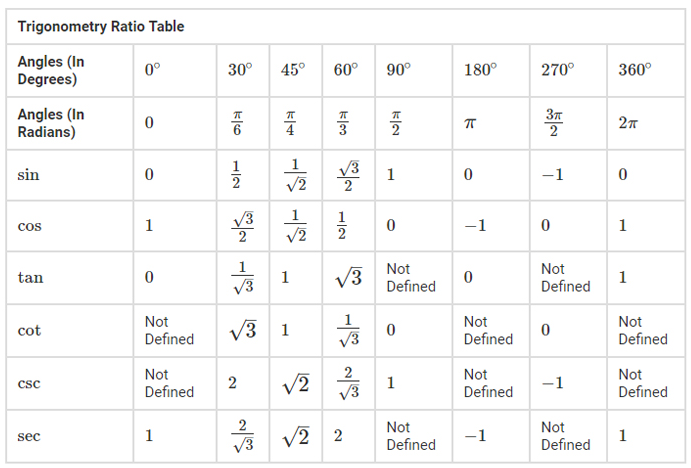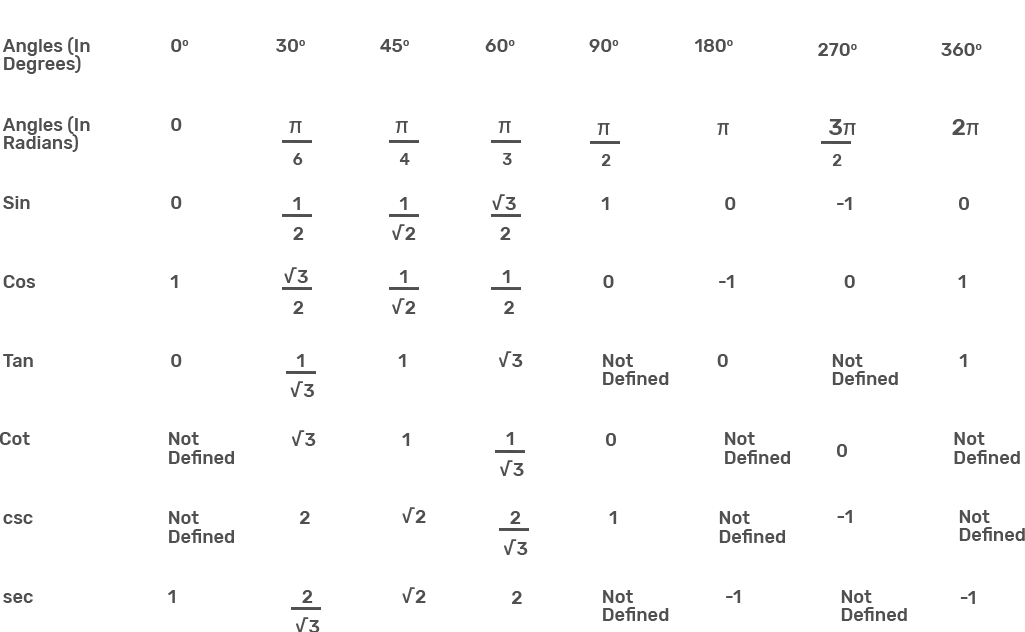Do you want to learn trigonometry but feeling confused with the trigonometric table of all Angles? Well, we have got your back here as we will make it easier for your understanding. The article would explain the significance of the trigonometry table in the context of trigonometry.
- Integration Formula
- Formula of Trigonometry
- Trigonometric Ratios
- Trigonometric functions with Formulas
- What are Trigonometric derivatives
- Heights and distance
- Trigonometry formula Involving Sum Difference Product Identities
- Trig Identities
- Pythagorean Theorem
- Differentiation Formula
- Basic Trig Identities
Trigonometric Table of All Angles
The trigonometry table is basically the integral part of trigonometry as it contains the whole structure of trigonometry. In simple words, the trigonometry table defines and states the value of trigonometry ratios. It includes the ratios such as sine, cosine, secant, etc. These are also known as the functions of trigonometry. So with the trigonometry table, one can easily get to know the value of these ratios or the functions.

The trigonometry table is therefore very significant since without this table one can’t solve the various problems of trigonometry. You can refer to the trigonometry table to know the values of various trigonometric functions. The table further shows that how the trigonometry functions or the ratios remain related to each other.
However, there may also be a variation in the case when you take the different trigonometric ratios. The main usage of the trigonometry functions is in the overall measurement of the right triangle. With the proper trigonometry formulas, you can determine the overall area of the given triangle.
Trigonometric Table in Radians
Well, as we all know that trigonometry tables are highly relevant in the domain of mathematics. However, there is a number of other places where this table holds relevance. Before the advent of computer technology, trigonometry tables were highly useful in the domain of science, engineering, and even navigation. It was after the introduction of modern technology when the trigonometry table lost its relevance.
At the present time, the main usage of this table is only limited to mathematics. Scholars generally memorize the tables so that they can easily put the various values in the question. They also have the option of understanding the derivation of the fundamental of the trigonometry tables for their ultimate understanding.
FAQs on Trigonometric Table of All Angles in Radians :
Q: What is a trigonometric table?
A: A trigonometric table is a table that lists the values of trigonometric functions for specific angles. These tables are used in mathematics, science, and engineering to simplify calculations involving angles and triangles.
Q: What are the trigonometric functions?
A: The trigonometric functions are six mathematical functions that relate the angles of a right triangle to the lengths of its sides. The six functions are sine, cosine, tangent, cosecant, secant, and cotangent.
Q: What are radians?
A: Radians are a unit of measurement for angles. One radian is defined as the angle subtended at the center of a circle by an arc that is equal in length to the radius of the circle. Radians are used in mathematics and science because they have some properties that make them easier to work with than other units of angle measurement.
Q: What is a trigonometric table of all angles in radians?
A: A trigonometric table of all angles in radians is a table that lists the values of the six trigonometric functions for every angle between 0 and 2π radians (or 0 and 360 degrees).
Q: Why would I use a trigonometric table?
A: You might use a trigonometric table if you need to perform calculations involving angles and trigonometric functions. For example, if you need to find the sine of an angle, you can look up the value of sine for that angle in the table rather than calculating it yourself.
Q: How do I read a trigonometric table?
A: To read a trigonometric table, first find the row that corresponds to the angle you are interested in. Then, read across the row to find the values of the six trigonometric functions for that angle.
Q: Are there any shortcuts or tricks for using a trigonometric table?
A: Yes, there are some shortcuts and tricks you can use to make working with a trigonometric table easier. For example, you can use the fact that the sine function is an odd function and the cosine function is an even function to quickly find the values of these functions for certain angles.
Q: Can I use a calculator instead of a trigonometric table?
A: Yes, most scientific calculators have built-in trigonometric functions that can be used to quickly find the values of sine, cosine, tangent, and other trigonometric functions for any angle. However, a trigonometric table may still be useful in some situations, such as when working with historical or non-standard angle units.
Q: How accurate are trigonometric tables?
A: Trigonometric tables can be very accurate, but the level of accuracy depends on the number of decimal places used in the table. Most tables include values rounded to several decimal places, but if you need greater accuracy, you may need to perform your own calculations using a more precise method.


